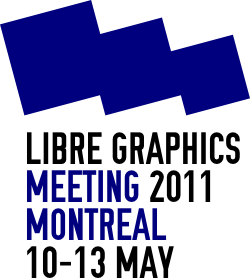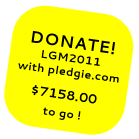Day 3
Thursday May 12 2010
09:00
Open Mind, Literally: Teaching Free Culture As A Life Goal, Brain Surgery, and A Networked Path to Recovery
Pete Ippel
http://thephysicalword.hypermodern.net
Video
LGM 2010 was a new experience for me, and has greatly influenced my teaching, my art, and my perception. While I was in London returning from Brussels, I received a call from the San Francisco Art Institute to teach a freshman foundation course titled “”Making and Meaning”". It was the first time I had the opportunity to create my own syllabus for undergraduates, so I chose to teach about free culture, and how create work and consider open principles when executing projects. http://hypermodern.net/2010/08/24/making-history-free-and-open-culture/
Three weeks away from the end of the semester I was struck by a nearly life-ending infection. A fellow free culture advocate came to my aid, teaching in my place, and helped to produce and inspire a project called “”The Physical Word.”"
In this presentation, I will share my story of how the principles of LGM serve as inspiration to recovery and regrowth.
http://thephysicalword.hypermodern.net is the project that was created utilizing concepts from LGM.
09:30
Data Viz: Open Source and Sources
Stéphanie Vidal
http://twitter.com/minniefractale
Video
“”The main question with data today, is not so much their existence but what is processed, their continuous use and applications,”" said Jérémie Zimmerman from La Quadrature du Net, a French organisation that aims to defend the rights and liberty of Internet users. Today, data is everywhere around us. They were around yesterday but we did not have the means to work with and visualize them on massive scale before. Thanks to the Internet and the value of sharing and transparency engendered by its long-time users, we can nowadays access and find tools to process massive amounts of data and reveal information that used to stay hidden in lists of numbers.
On one side, companies, governments and media put more and more datasets at our disposal. On the other hand there is more and more specialized and specified softwares that are provided to treat and visualize this profusion of information, and many of these tools are indeed, open source.
To play on words, information sources could be considered as “”open sources”". Like never before, anyone may gain access to a significant amount of raw information via an Internet connection. Of course, not all of the datasets are available and sometimes we would prefer this raw information to be delivered at in better formats, but so much is ready to be cooked.
In terms of expertise, datasets and softwares are no longer just the turf of scientists and journalists, artists and amateurs are exploring them. The increasing number of data-visualizations produced by people or making platforms that help people to create their own visualizations is an emerging tred.
This presentation, focuses on data visualization. It puts in perspective the notion of information and its possible changes in this “”open sources”" world. The presentation of several examples taken in from media and some artists portfolio is shown, as well as paths for audience to get involved.
Etymologically, information is what is put into form. Does the fact that we can all potentially process databases, extract meanings out of the information and visually represent data thanks to open source tools, modify the shape that information used to have and the how we used to interact with it?
10:00
Tau Meta Tau Physica – Open Source Digital Pattern Making software
Susan Spencer Conklin
http://www.tmtp-project.org
Video
* I. Presentation of project development during the previous 12 months.
o I1. Description of software development from manual technique to procedural code to object oriented code.
o I2. Discussion of how the pattern was separated out, leaving a generic engine. This coding approach allows the designer to retain pattern rights while the engine is open source software.
* II. Illustration of how a beginner can develop an idea and take it forward.
* III. Presentation of current product.
16:30
DeviantArt: Creating Community Around Creativity
DeviantArt,
Michael Halpert
http://deviantart.com
Video
In the 10 years since it’s inception, deviantART has become the home for over 17 Million Artists with an audience of over 45 million people all around the globe. The site provides an exhibition environment, community tools and resources for artists at all skill levels, in all mediums. As a supporter of the open-source software movement, deviantART hosts millions of creative works, tutorials, assets, brush packs, skins and resources for all of the major projects. The Groups platform also creates environments for people to collaborate around software projects to share and curate their favorite artwork and resources. Gilles and Mike from deviantART are here today to discuss new opportunities for interfacing directly with this massive online platform.
Mike Halpert works with the business development and product groups at deviantART. His work includes numerous popular products such as Portfolio, the dA Mobile site and numerous e-commerce offerings. Prior to deviantART, Mike worked in creative development at Lawrence Bender Productions and the prestigious William Morris Agency. Halpert is a graduate of the Tisch School of the Arts at New York University.
Gilles Dubuc is one of the team leads of the Devious Technology department at deviantART. Since joining deviantART, he has worked on core products such as the groups platform and notes, has rewritten large components of the website and pioneered innovative optimization techniques. Prior to deviantART, Gilles worked for several companies including SMS Central Pty Ltd and Sun Microsystems. He also founded two startups. He graduated from Napier University in Edinburgh, Scotland.
10:45
OSP: Adventures in distributed design
OSP OSP
http://ospublish.constantvzw.org
In 2010-2011, OSP worked on various commissions and self-initiated projects including fonts, publications and web projects. We would like to show you some snapshots from a busy year in which we distributed our practice through exchanges with colleagues in Africa, Asia and Europe, and with the help of a GIT-repository that became the central repository for our creative work.
14:00
How to keep and make productive libre graphics projects?
Ale Rimoldi:
http://www.graphicslab.org/Blog
Asheesh Laroia:
http://asheesh.org/
Bart Kelsey:
http://opengameart.org/
Every now and then, a new article appears, where somebody relates how bad newcomers are welcome in the free software world. This seems to specifically apply to contributions from non-programmers.
Having heavily participated in the Scribus project (mainly not as a coder) and having looked at several other graphics projects I must say that we are better than average and succeed in getting non programmers to be at fully integrated in our projects.
Still, most of our projects are marked as not ready to be used by many people: lack of features, bad interaction design, ugly GUIs, … Even if our answer is often: “”come and work with us”", we lack good people working on it. And we mainly lack of programmers who give us code!
In this panel I’d like to get the people who have ideas on how to improve the participation in the graphics free software talk with the developers who want to try to improve the productivity of their projects.
I will propose some introductory texts as a base of the discussion and I will try to get two or three people to give a short speech (on both sides: proposing solutions and needing help).
15:30
Make free art now! Creativity with free software: FooCorp, GNU FM and the Free Software Foundation
Matt Lee
http://www.foocorp.net/
With free software, everyone can be an artist. How free software tools are used at the Free Software Foundation, to publish a magazine with a circulation of 20,000, and at FooCorp, the free software and free culture production company — releasing records, publishing books and more with free software. Also: GNU FM — a platform for the free culture artists signed to FooCorp and others.
10:30
A manhole to West Africa
Magaouata Dan Bourgami
This talk is about our subjective view of:
* Free Software in West Africa
* Developers communities in West Africa
* The challenges of textbooks publishing in West Africa
* Graphic and interactive creation with Free Software
17:15
Open Colour Standard: Dissipating the vapour
ginger “all-lower-case” coons
http://adaptstudio.ca/ocs
Video
The trek towards a F/LOSS compatible spot colour standard for print design (among other things) has been a long and arduous one. This talk presents work (two years in the making) towards setting a sensible, workable, accessible baseline for F/LOSS spot colour. It presents the first concrete work towards that end: a palette of screen printing inks based on public standards and baselines. It will be colourful. There will be swatches.”,”ginger “”all-lower-cas
15:30
How to make SVG speak spot color language
Louis Desjardins
http://www.mardigrafe.com
Video
Going through the steps of a real case study, we will see how we managed to put together a web-to-print workflow going from RGB colors from SVG files to spot colors including tints. A trip from Drupal to gnuplot to Inkscape to Scribus to PDF… A travel from the web to the print. And a big book in the end.
17:30
Print: The Final Frontier
Jon A. Cruz
http://codewideopen.blogspot.com/
Video
Linux and open source in general have made great inroads into the graphics art world in the past decade. Their adoption in the movie industry is unquestioned, with the likes of Pixar, Weta Digital, Digital Domain, Disney, Dreamworks, ILM and others all embracing them. However, there is still an area that remains largely unconquered. This industry is long overdue to see the benefits others have long enjoyed, and it is the next frontier: print and pre-press.
Proprietary vendor-locked standards, heavy inertial, and fairly arcane knowledge have let this area lay fallow for far too long. Complicating the hold of traditional methods, is the lack of awareness that abounds. Both those in the industry being unaware of the potential for alternatives and also the people who could bring improved open source solutions being unaware of the complexity and requirements of the field are slowing adoption.
This situation, however, is ready to change. Those in the open source community have been working on collaboration across the board, including solving technical issues and enhancing workflows for many areas. Color management and proprietary color standards are just a few of the issues being addressed. At the same time, those in the industry including different ink and paint vendors are now aware of a looming paradigm shift, and have been taking proactive steps to move with the times. Additionally, even some nations have stepped up to promote and enhance the use of Linux and other open solutions.





















Follow Us